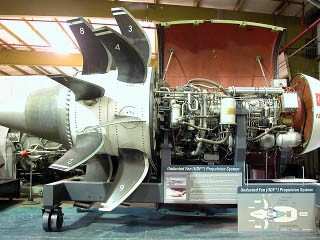Plan Wind-Tunnel Tests For Possible Alternative To P&W
Geared Turbofan
 GE Aviation and NASA are teaming on
a wind-tunnel test program to evaluate counterrotating fan-blade
systems for "open rotor" jet engine designs that could sharply
reduce fuel consumption.
GE Aviation and NASA are teaming on
a wind-tunnel test program to evaluate counterrotating fan-blade
systems for "open rotor" jet engine designs that could sharply
reduce fuel consumption.
The testing will begin in wind tunnel facilities at NASA's Glenn
Research Center in early 2009 and continue into mid-year. This is
not a full engine test, but a component rig test to evaluate
subscale fan systems using GE's and NASA's advanced computational
tools and data acquisition systems.
Rising fuel prices have led GE and NASA to re-visit open-rotor
engine systems. In the 1980s, GE successfully ground-tested and
flew an open-rotor jet engine that demonstrated fuel savings of
more than 30 percent compared to similar-sized, jet engines with
conventional, ducted front fan systems.
The original open-rotor design was later surmounted by more
conventional turbofan technologies, and the advent of small
regional jets... but since then, fuel prices have skyrocketed anew,
and GE says it has dramatically advanced its data acquisition
systems and computational tools to better understand and improve
open-rotor systems.
"GE and NASA journeyed down this path 25 years ago with great
technical success," said David Joyce, president of GE Aviation.
"Today's fuel crisis greatly influences future jet engine concepts.
GE and NASA will evaluate open-rotor concepts in the wind tunnel
with far greater technology capability."
For the NASA tests, GE will run two rows of counterrotating fan
blades at 1/5 subscale in several configurations, tested in
simulated flight conditions created in Glenn Research Center's
9-by-15-foot low speed and 8-by-6-foot high speed wind tunnels.
GE and the Fundamental Aeronautics Program of NASA's Aeronautics
Research Mission Directorate in Washington are jointly funding the
program. Snecma (SAFRAN Group) of France, GE's longtime 50/50
partner in CFM International, a highly successful joint company,
will participate with fan blade designs.
Open-rotor jet engine designs are among the longer-term
technologies being evaluated for LEAP-X, CFM International's
(GE/Snecma) technology program focusing on future advances for
next-generation CFM56 engines.
NASA's testing rig equipment, which is being refurbished for the
activities, was actually used in the 1980s when NASA and GE jointly
tested scale-model, counterrotating fan systems that led to the
development of the GE36 jet engine. The NASA test hardware is also
capable of simulating aircraft installation systems with the
open-rotor fan systems.
The GE36, which flew on Boeing 727 and MD-80 aircraft, featured
an aft-mounted, open-rotor fan system with two rows of
counterrotating composite fan blades. The enormous efficiency from
bypass air created by this fan system drove the GE36's dramatic
fuel savings. Snecma was a 35 percent participant on the GE36
program. As fuel prices fell sharply in the late 1980s and early
1990s, the GE36 was never launched commercially, though it was
recognized worldwide as a technology breakthrough.
The upcoming rig tests will focus mostly on the acoustic
characteristics of various fan configurations, as well as
performance and efficiency characteristics. Engine noise is a prime
challenge in operating open-rotor engine systems in a commercial
aviation environment.
GE Aviation hopes the technology may provide an alternative to
competitor Pratt & Whitney's planned geared turbofan design,
which promises fuel savings in the 30-percent range.
 ANN's Daily Aero-Linx (04.16.24)
ANN's Daily Aero-Linx (04.16.24) Aero-News: Quote of the Day (04.16.24)
Aero-News: Quote of the Day (04.16.24) Airborne 04.10.24: SnF24!, A50 Heritage Reveal, HeliCycle!, Montaer MC-01
Airborne 04.10.24: SnF24!, A50 Heritage Reveal, HeliCycle!, Montaer MC-01 Airborne 04.12.24: SnF24!, G100UL Is Here, Holy Micro, Plane Tags
Airborne 04.12.24: SnF24!, G100UL Is Here, Holy Micro, Plane Tags Airborne-Flight Training 04.17.24: Feds Need Controllers, Spirit Delay, Redbird
Airborne-Flight Training 04.17.24: Feds Need Controllers, Spirit Delay, Redbird



